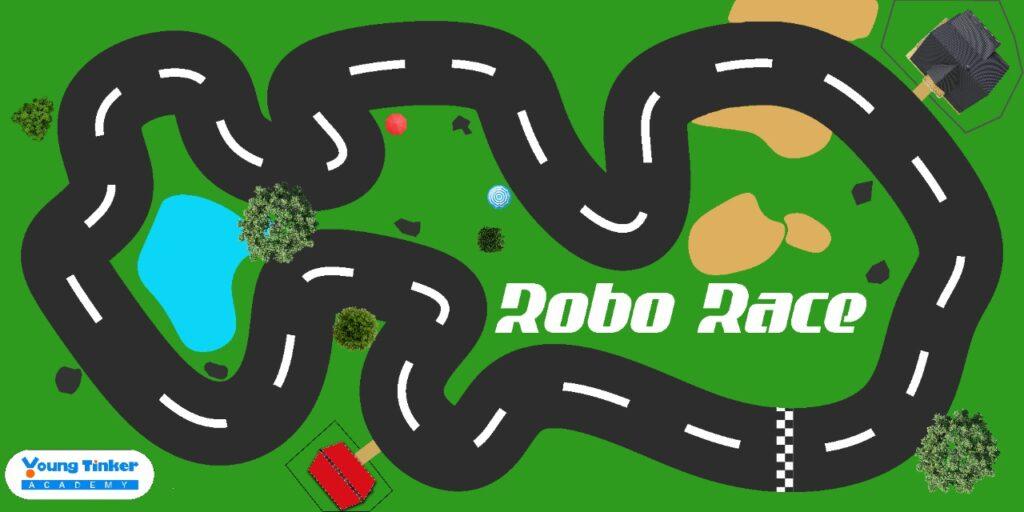RULES & REGULATIONS FOR ROBO RACE
The goal is to build your own robot, either wired or wireless, within the required specifications in order to obtain the highest speed possible in order to outrun other robots on the track and cross the finish line in the shortest time possible.
Points to keep in mind
- Lego kits are strictly prohibited. Do not create robots with pre-assembled kits. If such robotics are found, the participant will be disqualified.
- Robots must be non-destructive and harmless to humans and railroad tracks.
- The radio system must not cause interference to other radio frequency users.
- The cable length (for wired bots) should be long enough to cover the entire track (approximately 12 meters). Also, the cable must be slack while crossing the track.
- Participants need to organize their own batteries.
- The use of internal combustion engines or compressors is not permitted. All vehicles need to rely solely on electric motors for movement and control.
- The robot must not emit smoke, fire, leaks, dirt, or dirt.
- 3D printed parts are not allowed.
Dimensions: The following size restrictions apply to each robot
- Width – Not more than 25 centimeters
- Length – Not more than 30 centimeters
- Height – Not more than 25 centimeters
- Maximum weight must not exceed 2 kg (including battery for wirelessly controlled Robots). However, a tolerance of 5% is acceptable.
Power Source
- Only electric robots are allowed at the event.
- The battery must be of a sealed and immobilized electrolyte type (gel, lithium, NiCad, or batteries).
- No voltage in the machine should exceed 12VDC at any time.
- The battery can be attached to the robot. For wireless robots, you can carry it in the hands of the robot operator.
Construction: Any robot parts/constructing cloth may be used till the robotic meets the above specs.
Track details:
- The competition track has a track of total length 22 ft 10 inches
- The track will be 20 cm wide.
- The track will be having certain checkpoints before the hurdles.
- The track surface and course line may have un-evenness
- Different hurdles will be there on the race track trying to slow down the Robot.
- Predefined Obstacles for the competition will include Switch Bridge, speed breakers, marble pit, slippery path, rotating ting disc, curve ramp down, seesaw etc.
NOTE: Actual track design may vary from the one shown in the image below and is subject to change before the event commence.

Gameplay
- The competition is divided into two trial runs
- Each participant will have 2 trial runs. After the trials are over, the fastest time achieved during those trials will be chosen for the participant.
- One trial should not last more than five minutes. After the trial time is over, the TIME-UP BUZZER will sound, and the participant will be asked to remove the robot from the COMPETITION FIELD.
- Any time used to adjust the robot between runs is included in the 5 minutes. The run (from the start to the finish point) in which a robot successfully reaches the destination point will be given as a run time. The minimum run time shall be the robot’s official time.
- Each competing Robot will be given points for successfully overcoming the hurdles present on the track. Points allocated to different hurdles will depend
- upon the difficulty level of the same. Total points achieved for successfully overcoming the hurdles will be added to the final run time of each participant in order to calculate the final score. If the participant skips any hurdle, they will lose the point for the same.
- Negative points will be awarded for each time the Robot moves out of the track.
- Each run will start from the starting point. The operator may abort a run at any time. If an operator touches the robot during a run, the participant will score negative points and shall start from the previous checkpoint. If a robot has already crossed the finish line, it may be removed at any time without affecting the runtime of that run.
- The run timer will start when the front edge of the robot crosses the start line and stops when the front edge of the robot crosses the finish line.
- Negative points will be awarded for every human touch which will affect the final score of the participant.
- The first prize goes to the robot with the shortest official time and achieves the maximum no of points. Second prize to the next shortest, and so on.
- If there is a tie, another chance will be given to the participants.